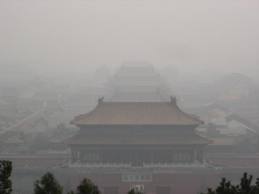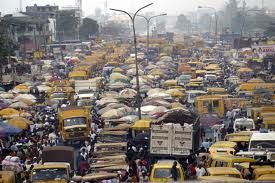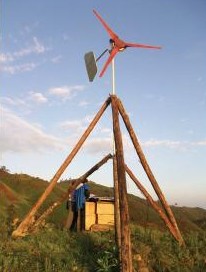In our last blog we talked about the challenge of dealing with solid urban waste in cities in both the Developed and Developing World. With urban growth in the 21st century expected in cities of the Developing World, add managing the air to the litany of challenges to be faced and overcome.
Developed World cities have the same problems with air pollution as cities in the Developing World. The difference is in length of time in which these problems have appeared. Developed World cities grew at a slower pace than the Developing World cities of today. So although emissions from automobiles, trucks, home heating, industrial plants, and power stations contributed to ground-level ozone, CO2, and urban-created smog, these problems became apparent over a half century or more, not over a decade or even less time than that.
Air pollution in cities spreads far and wide regardless of the location of the city in the Developed or Developing World. In addition the demands cities put on their hinterlands exacerbate the problem. Cities need energy. Coal-fired power plants produce that energy and may be hundreds of kilometers away but their emissions pollute from point of origin and downwind often contributing to greater problems for the cities they heat and light.
Beijing, China, experiences many days each year when air pollution reaches such dangerous levels (see picture below) that it is unsafe to be outdoors. Cities of the Great Lakes in Canada and the United States get the drift of air pollutants from local origin as well as the emissions from coal-fired power plants up wind. Tailpipe emissions from cars, trucks and buses create ground-level ozone making walking on local sidewalks in urban settings hazardous to the health of those who have asthma or other respiratory diseases.

Air Pollution in Urban China
Before Beijing hosted the Olympics,it began a program to greatly decrease air pollution. This involved restricting traffic, reducing the operations of coal-fired power plants, and limiting the hours that heavy industry could operate. Even with regulation the quality of the air during the 2008 Olympics was only marginally better. When measured throughout the Games Beijing air contained higher than acceptable levels of ozone, sulfur dioxide (SO2), carbon monoxide (CO), carbon dioxide (CO2), reactive aromatics (toluene, xylene), nitrogen dioxide (NO2), reactive nitrogen (NOy), alkanes and benzene. For the athletes the exposure presented minimal risk but for Beijing citizens living in the city before and after the Games, air pollution is a major contributor to chronic respiratory disease.
Air pollution in China is not limited to Beijing. Shanghai, China’s largest city, experiences air pollution so thick that residents report it is often impossible to see buildings a few blocks away, or the road from as little five stories above. Beijing and Shanghai have had to close their international airports on days when the air pollution has made it impossible to safely take off and land. Space shuttle and International Space Station astronauts have reported that many of China’s cities are invisible from space because of the blanket of pollutants that shroud them from view.
For China’s it is a tradeoff between air quality and production and its urban population as its economy rapidly expands. In a 2010 study of air pollution in urban China it stated that one-third of 113 Chinese cities failed to meet air quality standards. A World Bank report indicated that 16 of the 20 worst air polluted cities were in China with 20% of the urban population exposed to heavily polluted air. The primary cause is the burning of high-sulphur coal, the principal mined fossil fuel in China. Six million tons is burned daily not just for power and industrial plants, but also as a domestic heating and cooking source. The total health cost of airborne particulate matter in a 1995 study was estimated to equal $54 billion annually or 8% of Gross Domestic Product (GDP). Considering the expansion of the Chinese economy since 1995, that number is today much greater. Today China is adding a new source of air pollutants to the mix. The number of motor vehicles is rapidly on the increase. The result, airborne lead in major Chinese cities such as Shenyang and Shanghai is contributing to blood-lead levels 80% percent higher than those normally considered dangerous to mental development. With a rising middle class and a lot more automobiles and trucks on the road lead pollution will only get worse.
Air Pollution in Developing World Cities
The same factors that contribute to the problems in Chinese cities exist in cities throughout other parts of the Developing World. More than a billion urban dwellers in these cities experience dangerous levels of air pollution, contributing to 2 million premature and prenatal deaths annually. It is estimated that urban air pollution costs Developing World countries 5% of GDP annually compared to 2% for the Developed World. More than 90% of the pollution is attributable to transportation and domestic use, not power and industrial plants as in China. Older vehicles, poor vehicle maintenance and poor-quality highly leaded gas are major culprits. Burning kerosene and other fuels for domestic cooking contribute to the bad air in these urban environments. Local industries rely on diesel generators because of a lack of power from central utilities.
In Lagos, a city we have documented in previous blogs, traffic, flaring of waste gas from petroleum refineries, kerosene burning for cooking, and incineration of solid wastes, have contributed to air pollution that is 500% higher than safe levels established by the World Health Organization (WHO). In 2007 the WHO estimated that air pollution contributed to 14,700 deaths in Nigerian cities.

Solutions for Cleaner Air in Developing World Cities in the 21st Century
What can be done to clean up the air over the cities of the Developing World? What is affordable? What technologies exist today or will exist in the near future to mitigate and end this growing problem that not only contributes to premature death but also to climate change?
In China, South Asia and Africa the goal to decrease air pollution involves a cooperative effort among government, industry and citizens. Technology solutions exist at the macro and microeconomic level. What are these?
Substituting cleaner fuels for generating power, heat and electricity. In China, washing coal before burning it would greatly decrease (SO2) and acid rain. Better yet getting off coal by finding alternatives will dramatically reduce many of the other pollutants that shroud Chinese cities. Diversifying means using renewable power sources such as wind, photovoltaics and other solar technology, hydroelectric power, nuclear power, natural gas and oil.
Today, China is the world’s largest manufacturer of wind turbines not just for export but also for domestic use. China is building variable-sized wind turbines with sizes deployable off the grid for rural power generation. Small wind turbines represent a supplementary power source for clusters of homes or single family dwellings.
One of the many challenges in cities in places like Africa is the lack of capital to invest in manufacturing at a level of sophistication and in quantity as in China. Instead, small-scale manufacturing projects involve the use of local materials. A good example is a project in Cameroon. The town of M’muock, population 7,000, is working with Green Step, a German company, to build and operate small wind turbines and other renewable energy power generators from locally sourced wood, and old car and radio parts.

Refining gasoline to get the lead out. Lead as an additive in gasoline was first introduced in the 1920s despite its known toxicity and it has taken 90 years to eradicate it from the production of this fuel. The United Nations has set a goal of 2013 to end production of leaded gasoline globally. Once this is achieved new lead sources will no longer contribute to the problem. But the residual environmental threat remains.
Even though leaded gasoline was banned in 1986 in the United States, lead remains in the soil and air because it is almost indestructible. For children this represents a greater risk because they ingest lead 5 to 8 times more rapidly than adults. Children absorb up to 50% of inhaled lead. Those living near highways, playing on roads or in playgrounds near parking lots are at greatest risk as dust with lead gets ingested into lungs.
Inexpensive lead remediation programs involve combining compost with contaminated soils to inactivate the lead. Lead when exposed to phosphates forms an insoluble compound. Similarly lead is remediated when exposed to soluble iron oxides.
Replacing polluting motor vehicles with low-emission and zero-emission alternatives. Older automobiles and trucks are major contributors to air pollution in urban environments. Emissions include (NO2) nitrogen dioxide, (CO) carbon monoxide, (CO2) carbon dioxide, benzene and other partially combusted hydrocarbons. Internal combustion engines (ICE) are the principal polluters even those with catalytic converters although a converter halves the amount of NO2 that gets into the atmosphere.The combination of partially combusted hydrocarbons, NO2 and sunlight cause ground-level ozone and smog. Recycling the older vehicles that clog the roads of Developing World cities can at least begin to reduce NO2. Proper maintenance of older vehicles to improve the air-to-fuel ratio can dramatically reduce CO emissions.
Ideally the arrival of electric vehicles with infrastructure for managing both the charging of batteries and their disposal will dramatically reduce air pollution.
Implementing emission control technologies in industrial and power generating plant smokestacks. Reducing emissions whether in cars or trucks, or from industrial and domestic sources will lower air pollution levels in Developing World urban centres. Proven technologies include:
Cyclones to create cyclonic motion in the smokestack air stream to cause pollutant matter to drop out. Cyclones are inexpensive and useful for removing large airborne particles only.
Settling Chambers like cyclones alter the air stream, not by spinning the gases but by passing them through a larger space in the smokestack causing the air speed of the effluent to drop and precipitating out large particles. Settling chambers are inexpensive to implement.
Wet scrubbers filter out pollutants from the air stream by passing through water. Pollutants combine with water droplets and precipitate into settling tanks. Pollutant-laced water is discharged into settling ponds which can become quite large over time and highly toxic.
Fabric filters use porous temperature and corrosion-resistant fabrics to remove pollutants from the air stream as it passes up the smokestack. The filters need frequent replacement.
Replacing kerosene and coal as domestic cooking and heating fuels with cleaner alternatives. Urban dwellings in Developing World cities may not have access to reliable utility-delivered electricity or natural gas. Being off the grid is more common than not. Using generators that run on gasoline or other highly polluting fuels just contributes to air pollution. Building homes that can generate their own electricity through wind, solar and battery storage is one way to reduce airborne pollution. Where the infrastructure can deliver reliable electricity and natural gas, reductions in pollution will result. Houses like those being built using Eco-Tec designs represent a model for construction in these urban environments.
In our next edition of urban landscapes we will address water pollution in the 21st century.








